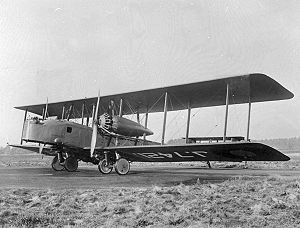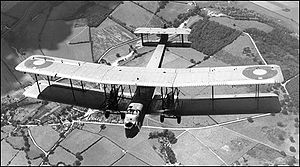Vickers Virginia Video - "Night Bombers" - Vickers Virginia - 1935
|
|
Vickers Virginia
Virginia

Picture - Virginia X J7421 RAF Museum photo: PC73/100/16
Role: heavy night-bomber
Manufacturer: Vickers Limited
First flight: 24 November 1922
Introduced: 1924
Retired: 1941
Primary user: Royal Air Force
Number built: 124
Developed from: Vickers Vimy

Picture - Vickers Virginia
The Vickers Virginia was a biplane heavy bomber of the British Royal Air Force, developed from the Vimy.
Design and development
The work on the Virginia was started in 1920 as a replacement for the Vimy, with two prototpyes being ordered on 13 January 1921, with a further two prototypes ordered in September 1922. The Virginia was similar to the Vimy, but notably had a lowered front gunner's pulpit to allow the pilot a greater field of view, 20 ft (6 m) greater wingspan, and a 9 ft (3 m) longer fuselage. The Virginia was powered by twin Napier Lion engines. The Virginia flew for the first time on 24 November 1922.
At the Aircraft Experimental Establishment at Martlesham, the Virginia prototype underwent type trials. One of the first modifications was to replace the original two-bladed propellers with a four-bladed example. An unusual set of "fighting top" turrets were added to the top wings but were later deleted from production aircraft.
The Marks I-VI had straight wings, whereas the Mark VII introduced swept outer wings. Starting with the Mark III the Virginia mounted a rear fuselage gunner, who was moved into a tail turret in the Mark VII.
The Mark X was introduced in late 1924 and featured a duralumin and steel structure covered in fabric, aluminum, and wood.
A total of 124 Virginias were built, of which 50 were Mark X variants.
Operational history
The first squadron of Mark I Virginias was assembled in 1924. Despite mediocre performance the aircraft served frontline units until 1938, when it was replaced by the newer Wellingtons, Hampdens and Whitleys. Newer designs such as the Fairey Hendon and Handley Page Heyford supplemented rather than replaced the Virginia.
The final almost all-metal Virginia Mark X was the most numerous RAF bomber until the ascendance of the Heyford in 1934. After its technical obsolescence as a bomber it was used for photography and for parachute training, with jump platforms installed behind the engine nacelles. On 26 June 1940, a committee discussing the need for airborne cannon for use against invasion tanks included the suggestion of equipping Virginias with the equally antiquated 37 mm (1.46 in) Coventry Ordnance Works gun. This was not acted on.
In the 1930s, the Virginias were used in some of the first tests of midair refuelling, although they were never used in this role outside of tests.
The Virginia was developed in parallel with the Vickers Victoria freighter, and the two aircraft had much in common, notably sharing the same design of wing.
The Virginias were highly accident prone, with 81 lost in this manner. Despite their obsolete status, Virginias continued to soldier on in support roles with the Parachute Test Flight at Henlow until December 1941.
Variants
Type 57 Virginia Mk I
Initial prototype for the RAF, powered by two 450 hp (340 kW) Napier Lion piston engines. One prototype only.
Type 96 Virginia Mk I
The first type 57 Virginia prototype was re-engined with two 650 hp (490 kW) Rolls-Royce Condor piston engines. One prototype only.
Type 115 Virginia Mk VIII
The Type 96 Virginia prototype was fitted with a lengthened fuselage, new forward fuselage and gun positions. One prototype only.
Type 129 Virginia Mk VII
The Type 115 Virginia was converted into the Virginia VII prototpye. One prototype only.
Type 76 Virginia Mk II
Second Virginia prototype, powered by two Napier lion piston engines, fitted with lengthened nose. One built.
Type 79 Virginia Mk III
Twin-engined heavy night bomber biplane for the RAF, powered by two 468 hp (349 kW) Napier Lion II piston engines, equipped with dual-controls. Six built.
Type 99 Virginia Mk IV
Twin-engined heavy night-bomber biplane. Similar to the Virginia Mk II, but with additional equipment.
Type 100 Virginia Mk V
Twin-engined heavy night-bomber biplane, equipped with a third (central) rudder in the tail unit. 22 built.
Type 108 Virginia Mk VI
Twin-engined heavy night-bomber biplane. This version introducted revisiions in wing folding and rigging. 25 built.
Type 112 Virginia Mk VII
Twin-engined heavy night-bomber biplane. This version had a redesigned nose, lengthened rear fuselage and sweepback wings. 11 built and 38 conversions.
Type 128 Virginia Mk IX
Twin-engined heavy night-bomber biplane. This version introduced automatic slats, wheel breaks and a tail gunner's position. Eight built and 27 conversions.
Type 139 Virginia Mk X
Twin-engined heavy night-bomber biplane. this version incorporated an all-metal structure. 50 built and 53 conversions.
Operators
United Kingdom
Royal Air Force
No. 7 Squadron RAF - May 1924 to March 1936
No. 9 Squadron RAF - April 1924 to May 1936
No. 10 Squadron RAF - September 1932 to January 1935
No. 51 Squadron RAF - March 1937 to February 1938
No. 58 Squadron RAF - December 1924 to January 1938
No. 75 Squadron RAF - March to September 1937
No. 97 Squadron RAF
No. 214 Squadron RAF - September 1935 to April 1937
No. 215 Squadron RAF- October 1935 to September 1937
No. 500 Squadron RAF - March 1931 to January 1936
No. 502 Squadron RAF - December 1931 to October 1935
Henlow Parachute Test Unit
Video
Film of Vickers Virginia flight operations
Film of an experimental catapult launch of a Vickers Virginia
Specifications (Virginia X)
Data from The British Bomber since 1914
General characteristics
Crew: Four
Length: 52 ft 3 in (15.93 m)
Wingspan: 87 ft 8 in (26.77 m)
Height: 18 ft 2 in (5.54 m)
Wing area: 2,178 ft² (202.4 m²)
Empty weight: 9,650 lb (4,377 kg)
Max takeoff weight: 17,620 lb (7,993 kg)
Powerplant: 2x— Napier Lion VB inline piston, 580 hp (433 kW) each
Performance
Maximum speed: 108 mph (173 km/h) at 5,000 ft (1,520 m)
Range: 985 mi (1,585 km)
Service ceiling: 13,800 ft (4,210 m)
Climb to 5,000ft (1,520 m): 10 min
Armament
Guns: 3 x— .303 in (7.7 mm) Vickers machine guns
Bombs: 3,000 lb (1,360 kg) of bombs
Related development
Vickers Victoria
Bibliography
Andrews, C.F. and E.B. Morgan. Vickers Aircraft since 1908. London: Putnam, 1989. ISBN 0-85177-851-1.
Jarrett, Philip. "By Day and by Night:Vickers Virginia". Aeroplane Monthly, May 1993, Vol 21 No 5, Issue No 241. ISSN 0143-7240. pp. 24-29, 45.
Mason, Francis K. The British Bomber since 1914. London: Putnam, 1994. ISBN 0 85177 861 5.
Morgan, Eric. "Big Bombers from Brooklands: The RAF's Virginia Family." Air Enthusiast, Thirty-one, July-November 1986, pp. 34-42, 7179. Bromley, UK: Fine Scroll. ISSN 0143-5450.
Sturivant, Ray. "Vickers Virginia X J6856." Aviation News, Vol. 13, No. 22, 22 March-4 April 1985.
Thetford, Owen. "By Day and by Night: Ginnies in Service", Part 1. Aeroplane Monthly, June 1993, Vol. 21, No. 6, Issue No. 242, pp. 32-39. ISSN 0143-7240.
Thetford, Owen. "By Day and by Night: Ginnies in Service", Part 2. Aeroplane Monthly, July 1993, Vol. 22, No. 1, Issue No. 243, pp. 18-23.. ISSN 0143-7240.
Winchester, Jim. Bombers of the 20th Century. London: Airlife Publishing Ltd., 2003. ISBN 1-84037-386-5.
Vickers Virginia Pictures
Living Warbirds: The best warbirds DVD series.
Source: WikiPedia